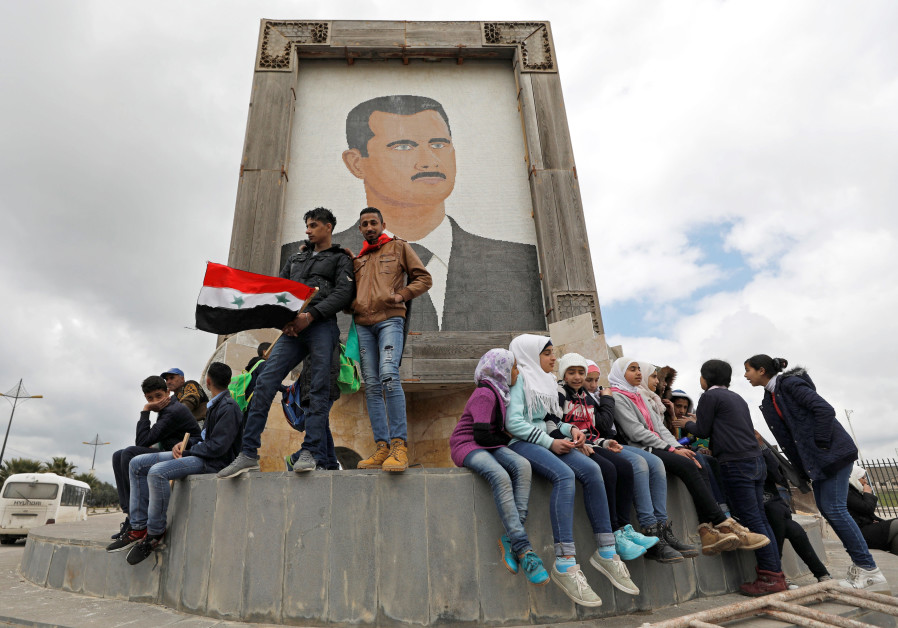Questions remain after Israel strikes Syrian air-defense system – analysis

A man holds the Syrian flag in Quneitra near Golan Heights (REUTERS/Omar Sanadiki). (photo credit: REUTERS/OMAR SANADIKI)
Israel said that a Syrian anti-aircraft system fired at an IDF fighter jet on Monday night. Israel responded by targeting the launcher that had shot at the plane. This is the very simple and clear statement that was released. It also said the Israeli jet that had been fired upon was on a routine flight in northern Israel.
Syrian sources have reported that the launcher that was hit, somewhere in the Khan Arnabeh and Quneitra area, was a Syrian ZSU-34-4 Shilka and the soldiers manning it were from the 121st brigade of the Syrian army. The main difference between the various Shilka models is the size of the guns on it, or caliber. For instance the ZSU-23-4 Shilka, which entered service in 1962, had four 23 mm autocannons with radar guidance.
This weapon system has been spotted often in Syria and its cannons have also been seen mounted on other vehicles or even positioned to be used apparently for ground defense. What that means is that this system doesn’t appear to be of the kind that would be used normally to target jet fighter planes, but rather helicopters or slower surveillance aircraft. The system can be updated like what was done with a new system developed by Belarus, mentioned this year in Russia’s TASS, which was armed with short range missiles and a robotized gun to deal with drone threats.
When the Syrian regime forces returned to the Golan border area there were tensions last summer. This was partly because of fears that Iran would use Syria’s return to the area for its own purposes. Israel has said that it struck more than 100 Iranian targets in Syria over the last years. According to Russia’s TASS, when the Syrian forces returned to the area around Quneitra they also recaptured Syrian army equipment from rebel forces. These included “10 Shilka self-propelled anti-aircraft guns.” That means we know that that Shilka was present in that area.
But questions remain about what happened on Monday night. Why did an antiquated Syrian air defense system fire at an Israeli jet? Why was the system so close to the UN-patrolled zone on the Golan border area?
Khan Arnabeh is directly on Line Bravo where the UN’s UNDOP is supposed to observe the ceasefire line buffer zone. The location of the strike was variously given in Iranian media as Khan Arnabeh or the Quneitra area in other Syrian media. Russia’s Sputnik called it Tel el-Shaar. All of these areas are very close to the sensitive ceasefire line.
Questions remain about why the Syrian air defense would seek to provoke an Israeli response. Over the years Syria has come to know that any rockets or anti-aircraft fire over the border or targeting Israel has resulted in retaliation. This has been the case throughout the fall of 2018 and into the first months of 2019. Syria’s regime is also involved in a massive build-up of forces near its northern Idlib province where it is trying to force Turkish-backed Syrian rebels and other extremists to leave an area that is under Turkey’s control. Why would Damascus create tensions with Jerusalem at this sensitive time?
Another issue involves Iran’s involvement. Iran and the US are in the midst of major tensions. Iran’s Hezbollah ally recently hosted a speech by its leader, Hassan Nasrallah, where he called for support of the Palestinians and opposition to US “plots.”
A third factor is the presence of Russian observers in southern Syria. After the Syrian government retook areas in the south the Russians sent military police and observers to the area as part of efforts to reconcile with the locals. Russia has in the past been closely involved in discussions with Israel about southern Syria. This has resulted in deconfliction agreements and also frequent discussions between Prime Minister Benjamin Netanyahu and Russian President Vladimir Putin. That leaves questions also about what the air defense officers near Quneitra were thinking last night when they decided on their rash course of action.
Join Jerusalem Post Premium Plus now for just $5 and upgrade your experience with an ads-free website and exclusive content. Click here>>






Comments are closed.